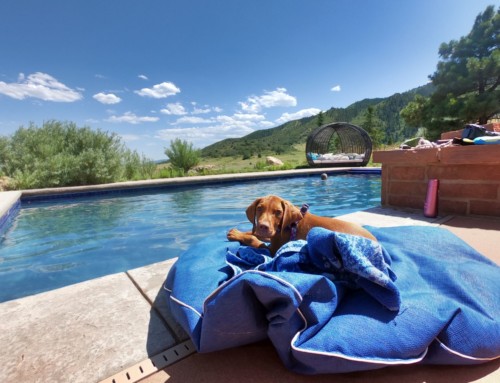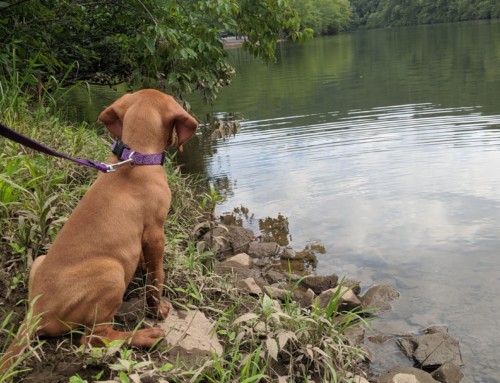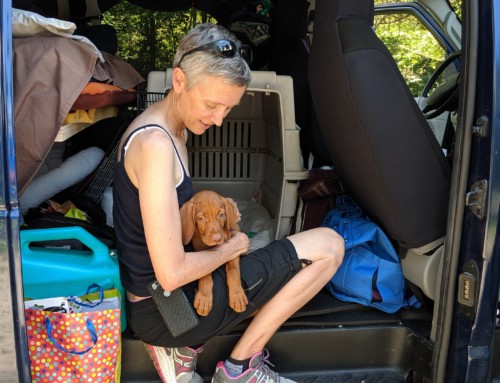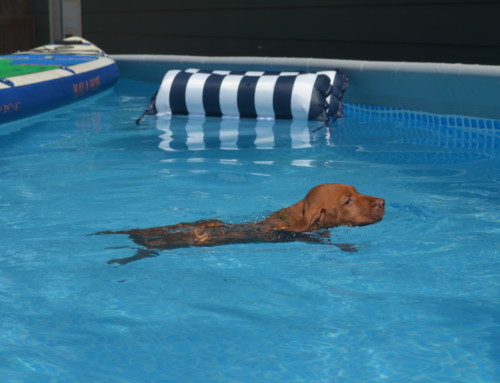DOG TRAINING OFFERED IN-PERSON AND ONLINEOur dog training services are delivered in almost any format that meets your needs. We have GROUP CLASSES at our indoor and outdoor facilities on our farm, ONLINE LIVE STREAMING classes, and SELF-PACED VIDEO-BASED training through our Online Dog Training Course. Our PRIVATE TRAININGS can be done in-home, outside, in public dog-friendly locations, at our facility on our farm, online via phone or video conferencing and through email. |
This post was originally published on El Perro Tambien and is an interview with Sue about travel tips with your dog. It is republished below.
Tell me about yourself as a trainer. How did you get started, how long have you been training, and where do you work now?
I currently run my own business, The Light of Dog, just south of the Denver metro area. We offer group classes, private in-home training, boarding and behavior consultations. I have also have two books, write a regular Ask the Trainer column for a newsletter, and we produce our own food and treat products and toys. I have been in this industry for over 20 years. I started out as a volunteer, learning on my own, attending seminars, reading everything I could, etc. I am a Certified Dog Behavior Consultant through IAABC and a Certified Professional Dog Trainer through CCPDT. I feel it’s important that we as an industry make an effort to begin setting some minimum standards to adhere to. As a trainer, I focus on positive reinforcement based training and being instructive to our dogs. I look at it as teamwork and both the canine and the human side need to learn to communicate and work well together. I believe my students are better trainers for their own dogs when they learn to listen to their dogs and not just focus on their dogs listening to them.
What three behaviors would you consider “must-have” for a dog that will be travelling a lot?
Rather than three specific behaviors, I look at it from a slightly different perspective. I look at two more general things a dog needs to be able to do. First is respond reliably to what you ask. Whether that is sit, stay, come, or some other cues, I think the specific cues will depend to some degree on what activities you plan to do. But is the ability to focus and respond quickly there? The second is to stay tuned in. If you’re away from home, it’s critical that your dog learn to stay tuned in to you and know where you are. Let’s say you plan to always have your dog on leash and don’t think you need off leash reliability. But what happens when your dog’s leash breaks, or you drop the leash, or any number of circumstances that can and will happen when your dog suddenly is not on leash? The goal if travelling a lot should be for off leash reliability even if you never plan to use it, because you never know when you will need it. So I’d say two things: responsiveness and tune-in.
Do you have any favorite exercises for starting to teach those behaviors?
Yes, I start out training with a new dog (regardless of age) with rewarding anything they offer that I like. Capturing and/or shaping behaviors that I like before I start working on putting anything on cue. From the get-go, my dogs learn that great things in life come from me. And that the most fun is to be had WITH me, not without me. So I start capturing things I like and then work to put those on cue, such as sit, down, come, stay, etc.
But my primary exercise getting started is eye contact. My dogs learn that eye contact is the best way to ask permission for things or to do things. It’s the best way to ask for help if they are unsure about something. It’s the best way to connect back and tune in with me. I spend more time on eye contact than any other thing in the early stages. When people meet my Vizsla, Romeo, they always comment on how tuned in he is with me. They are amazed at his focus on me. That did not come naturally! I worked hard on that, but I feel confident taking him lots of places because of that. He’s always aware of where I am and does not stray far.

What training foundations do people need before starting to go on outdoor, off-leash adventures with their dogs?
When I ask my students what they think is most important, they most often say a reliable Come is the top of the list. I tell them that I disagree. I think connection (for me, that comes through eye contact) is my most critical skill for off leash adventures. My philosophy is that if my dogs are tuned in with me and staying connected, I rarely ever need a reliable Come since they do not take off in the first place. While I certainly do want a reliable Come, I don’t want to need it very often.
Impulse control is another. Whether that is a Wait or a Stay or something else, the point is that if my dog cannot control his impulse to race off every time he gets excited about something, he’s not going to earn off leash privileges. And travelling is going to be more difficult. One of the first ones I teach is door manners or a Wait at all doors, gates, car doors, etc. Any time we are moving from one situation into another, my dogs have learned to connect on both sides so I can ensure it’s safe to proceed. This also helps prevent dogs from door darting. This can be especially dangerous when travelling if your dog darts out an unfamiliar door and takes off into unfamiliar territory.
As I mentioned earlier, I think the two most important things are reliable responses to a few things (for example, watch me, stay, and come) but also learning to stay tuned in and knowing where you are at all times. My Greyhound is super fast and her coloring blends in beautifully with the scrub oak in our area. So no matter how hard I try to keep track of her, it’s very easy for her to end up somewhere completely different from where I thought she was. So it’s critical that she knows where I am. I need her to understand that I don’t mind her having some fun within reason, but she needs to check back in as soon as she’s done. I can’t keep up with her, but if she’s making good choices, I can give her some leeway that I otherwise could not.
What (management) setups do you use while hiking or camping to keep your dog safe?
While our dogs mainly walk off leash, we always have leashes and will leash up or ask our dogs to heel if we are close to other people or dogs. They don’t know our dogs or how reliable they are or are not. They don’t know how friendly or not they might be. So out of courtesy to everyone, we leash up (or heel) when nearby and save our freedom to run around for when we have more space. We always try to respect the space of others. No one loves our dogs as much as we do, so we do our best to be courteous and respectful of others when out. And of course, follow local leash laws, if applicable.
We always have clear ID on our dogs as well as have them microchipped. No matter how well trained your dogs are, things happen. If we do get separated from our dogs, we want to ensure we have done all we can to make sure they can get back to use safely. Our ID includes our cell numbers we have with us so people can reach us immediately.
We use travel crates when driving. Our dogs have very comfortable travel crates (not too small) and are great in the van. On long trips, we ensure we get frequent breaks to get out and stretch legs and get water. If camping or just taking an extended picnic break or such, we can also use tie outs for safety if being off leash is not a good idea in some spots. For example, we never have our dogs off leash at a rest stop along the interstate. That close to a road with high speeds, I will never have my dogs off leash no matter how much I trust them.

What’s a training or behavior concept that will help keep your dog comfortable along the trip?
I teach my dogs “default” locations. At home, when they are young, their crate is one of those locations. When in doubt, the best place to show up is one of your “default” locations.
Heel (at my left side) is another default location. When on a trip, a default Heel is a good one to have. When you are out somewhere and nothing else is familiar, heel is a good spot to default to. Mat training can also be a good default. I have travel mats (they look sort of like a sleeping bag) that I always bring on our road trips. If we are staying with family, renting a cabin, staying in a hotel, etc., I bring in the mats and set them down wherever I want my dogs to lie down. They know that is their spot. If my dogs want something or are feeling unsure, going to a “default” location is a good bet.
What do you bring with your dog to help soothe him/her along the way?
When travelling, I always want my dogs to have something familiar with them to sleep on. Depending on where we are going and how much space we have, we might bring along their dog beds. If we have less space, we will bring their travel mats. We prefer to feed them out of their regular bowls they eat from at home. We want them to have things that are familiar and comfortable to help them settle in wherever they are.
I had a previous Greyhound who got very stressed riding in the car. No matter how many fun places we went (the majority of our car rides were for hikes) she was always stressed on the ride. She always wanted to go and loved being wherever I was. She just did not enjoy the ride. I started giving her Rescue Remedy about 30 minutes before we would depart. From then on, she would lie down instead of pace the entire trip. She still never loved rides, but she was better able to tolerate them with the Rescue Remedy.

What equipment would you never leave behind on a trip?
The leashes or long lines that we use when first getting going or in places where we need dogs leashed up use carabiners to attach to their harnesses, not clips. We have seen clips break or accidentally unclip. We always use carabiners that secure so we are less concerned about equipment failure.
We always have spare equipment along. Collars or harnesses can break or get chewed through. Leashes can break or get chewed through. Sometimes we encounter loose dogs who have escaped their collars or leashes. We try to have spares along in case of emergency.
We always have spare bowls in the vehicle for food or water in case we forget to pack our regular bowls.
We always have lots of poop bags to clean up! We always try to be courteous and never leave anything behind. We never want to contribute to dogs losing access to places because people do not clean up after their dogs.
We always bring high value treats along too. On one recent hike, we were out enjoying ourselves, had not seen anyone at all. We walk around the bend and suddenly see emergency vehicles and several people standing around. Next thing we know, a helicopter is circling and lands close by. Fortunately, our dogs did not panic. But they had never been anywhere near a helicopter before, let alone one flying over our heads. I had no idea how they would react, so we ensured lots of positive associations and they did fantastic!
What can travelers do to help their dogs acclimate?
Start with short trips. My Greyhound, Zuzu, used to be pretty cautious when we would go to new places. We would have to scope the place out for 10-15 minutes before she would move away from our vehicle. She needed to feel safe. So we did lots of short trips to check out new places before we did any travelling with her. Now, when we get to a new place, she will get moving right away. But she had to develop that confidence first.
How do you exercise your dog on the road? How do you find those locations if it’s not just a leashed neighborhood walk?
I have several options for exercise. While physical exercise is important, it’s not our only option. I certainly want my dogs to have options to stretch their legs and burn some energy especially if we are spending a lot of time driving and cooped up in our vehicle. But sometimes that’s not an option. One year we took our two dogs to visit our in-laws on California. Great weather there, dogs did great. But we took our time returning to Colorado and hit some spots along the way, including the Grand Canyon. We figured a winter visit would mean fewer crowds. Great idea, right? Except we hit a blizzard when we got there. Standing on the edge of the Grand Canyon and you could not tell you were there! White out conditions, part of the road was closed because it was too icy and cars were in danger of sliding off the roads. Below zero wind chill. We ended up having to stay overnight in a hotel nearby that we had not planned. How did we exercise our dogs? Lots of mental stimulation in the hotel. We practiced our tricks, did some training, and set up find it games to use their noses.
A quiet hallway worked great for working on some heel work and other training that required more space than we had in the room.
Any tips for keeping your routine while travelling?
Dogs tend to love routine and predictability. So I want to make sure I can provide some of that to my dogs, even if we are in an unfamiliar environment. For example, I might be covering a lot of miles and not in any one place for very long. But I can still provide some consistency by having a routine every morning when we get up. Or find a time each afternoon along our route to take a break and do something that helps my dog feel like this is “normal”. For example, my Vizsla, Romeo, gets nervous about a few things (gunfire for one). So if there is something that makes him nervous, we do some heel work or some tricks for treats to get his brain focused on doing something he knows. That always helps calm him down by doing something we work on anywhere and everywhere. He knows it, he enjoys it, and it helps him feel like he has some predictability in that situation.

With that, are there any characteristics that are red flags for you prior to travel?
I want to ensure my dogs are pretty well socialized and acclimated to a variety of places, people, things, noises, and such before any long trips. If I have a dog who is very insecure and panics, I might run into some serious trouble on a long trip. While you can’t plan for everything that could happen, I want to ensure that I have a dog with either enough confidence to handle new things and/or a dog who trusts me enough to help them through something they are not sure they can handle.
I would also consider things like. . . do I have a dog who gets very stressed during thunderstorms? Am I travelling during thunderstorm season and likely to encounter trouble? Do I have a plan for how I am going to handle that?
Are there situations where it might be best to leave Fido behind?
As mentioned above, if I have a dog who gets very stressed during thunderstorm season, I might avoid travel during that time. Or leave Fido behind on that particular trip. As much as I love having my dogs with me, I also don’t want to force something on them that they will not enjoy.
What sort of things do you see stressing dogs out that their owners might miss?
I sometimes see dogs who have started to shut down or avoid whatever is stressful to them, and owners often misinterpret that as the dog being “fine” with something. I think it’s important that people really learn to read their dogs and understand what information the dog is giving by how they are acting. I think far too often that we assume our dogs are fine if they are not trying to run away or trying to bite someone. We don’t have to wait for extreme responses before we can recognize that our dogs are uncomfortable or so afraid that they just shut down.
Trainers are human, too. Do you have any funny/embarrassing stories from traveling with your dogs?
My very first Greyhound, Gunner, and I did a lot of hiking. He was awesome and always stayed near me. It was quite a while before I would allow him to do part of our hikes off leash if no one else was nearby. So we had taken a short trip to get away, stay in a cabin and do some hiking. It was a pretty quiet area, so I let him off leash. Any time we would get near a blind turn, I would tell him to wait and he would wait for me to catch up before we proceeded. At one point, he went around a blind corner and I told him to wait, and assumed he was waiting just around the corner. Except, I got around the corner and he was not there. So I called him. And I called him. And I called him. So I started picking up my pace because I was starting to get worried now, because he had always responded quickly to me. So a minute or two goes by, which of course felt a LOT longer than that at the time. Finally, I hear someone off in the distance say, “He’s down here!” When I finally find the people and my dog, there is Gunner just hanging out with his new friends. They told me they saw him come out of the trees and were startled at first, not knowing what was coming at them. But Gunner was always very friendly and calm, so he had heard these people talking and decided to go make some new friends. You can bet he went back on leash for a while after that! But that never happened again for the rest of his life. He was an awesome hiking buddy.
Our goal is to positively impact the lives of as many dogs and their families as we can, in part through our extensive library of video, infographics and text articles. 
|













